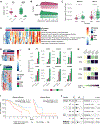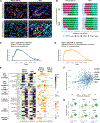Interrogation of the Microenvironmental Landscape in Brain Tumors Reveals Disease-Specific Alterations of Immune Cells
- PMID: 32470396
- PMCID: PMC8558904
- DOI: 10.1016/j.cell.2020.05.007
Interrogation of the Microenvironmental Landscape in Brain Tumors Reveals Disease-Specific Alterations of Immune Cells
Abstract
Brain malignancies encompass a range of primary and metastatic cancers, including low-grade and high-grade gliomas and brain metastases (BrMs) originating from diverse extracranial tumors. Our understanding of the brain tumor microenvironment (TME) remains limited, and it is unknown whether it is sculpted differentially by primary versus metastatic disease. We therefore comprehensively analyzed the brain TME landscape via flow cytometry, RNA sequencing, protein arrays, culture assays, and spatial tissue characterization. This revealed disease-specific enrichment of immune cells with pronounced differences in proportional abundance of tissue-resident microglia, infiltrating monocyte-derived macrophages, neutrophils, and T cells. These integrated analyses also uncovered multifaceted immune cell activation within brain malignancies entailing converging transcriptional trajectories while maintaining disease- and cell-type-specific programs. Given the interest in developing TME-targeted therapies for brain malignancies, this comprehensive resource of the immune landscape offers insights into possible strategies to overcome tumor-supporting TME properties and instead harness the TME to fight cancer.
Keywords: T cells; brain metastasis; cancer immunology; glioblastoma; glioma; microglia; monocyte-derived macrophages; neutrophils; tumor microenvironment; tumor-associated macrophages.
Copyright © 2020 Elsevier Inc. All rights reserved.
Conflict of interest statement
Declaration of Interests The authors declare no competing interests.
Figures







Comment in
-
Mapping the Uncharted Territories of Human Brain Malignancies.Cell. 2020 Jun 25;181(7):1454-1457. doi: 10.1016/j.cell.2020.06.003. Cell. 2020. PMID: 32589956
References
-
- Baddeley AD, Eysenck MW, and Anderson MC (2015). Spatial Point Patterns: Methodology and Applications with R (London: Chapman and Hall/CRC Press; ).
-
- Bates D, Machler M, Bolker BM, and Walker SC (2015). Fitting Linear Mixed-Effects Models Using lme4. Journal of Statistical Software 67, 1–48.
Publication types
MeSH terms
Grants and funding
LinkOut - more resources
Full Text Sources
Other Literature Sources
Medical

